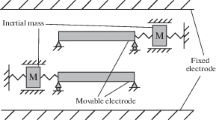Abstract
A comprehensive mathematical model of an accelerometer and its basic micromechanical sensing element is constructed that allows us to calculate and analyze the influence of mechanical and temperature effects, and of geometric, electromechanical, and other accelerometer characteristics and parameters, on the outgoing signals of the device with dynamic effects taken into account. The comprehensive model includes interlinked hierarchical mathematical models of the thermal processes of the accelerometer and its micromechanical sensing element, a finite-element model of the thermoelastic stress-strain state of the micromechanical sensing element, and a mathematical model of the dynamic drift due to temperature and deformation fields. Qualitative and quantitative estimates of the parameters of the thermal processes, the stress-strain state, and the drift of the accelerometer are obtained. Recommendations for minimizing drift are elaborated.
Similar content being viewed by others
References
Dzhashitov, V. E., Micromechanical precision accelerometer in the conditions of thermal effects / Dzhashitov V.E., Pankratov V.M., Papko A.A. // XI St. Petersburg International Conference on Integrated Navigation Systems—St. Petersburg CSRI Elektropribor, 2004, p. 189–199 (in Russian).
Sensors and the transforming equipment: Catalog/Russian Aviation and Space Agency, Federal State Unitary Enterprise “Scientific-Research Institute of Physical Measurements”, Penza, 2002. (in Russian).
Dzhashitov, V. E., Sensors, devices and systems for aerospace and marine instrumentation in thermal effects / Dzhashitov V. E, Pankratov V.M—St. Petersburg CSRI Elektropribor, 2005, 404 p.
Dul’nev, G.N. Methods of calculation of thermal regime of equipment / Dul’nev, G.N., Parfenov,V.G., Sigalov, A.V. -Moscow, Radio i svyaz’, 1990, 312 p. (in Russian).
Papko, A.A., The principles of formation of the dynamic characteristics of low-frequency accelerometers balancing transformation // Aviacosmicheskoe Priborostroenie, 2003, 17, p. 17–23 (in Russian).
Loycyanskiy, L.G., Mechanics of fluid and gas/Moscow, Nauka, 1987, 840 p. (in Russian).
Author information
Authors and Affiliations
Additional information
Original Russian Text © M.A. Barulina, V.E. Dzhashitov, V.M. Pankratov, M.A. Kalinin, A.A. Papko, 2008, published in Giroskopiya i Navigatsiya, 2008, No. 1, pp. 55–70.
Rights and permissions
About this article
Cite this article
Barulina, M.A., Dzhashitov, V.E., Pankratov, V.M. et al. Mathematical model of a micromechanical accelerometer with temperature influences, dynamic effects, and the thermoelastic stress-strain state taken into account. Gyroscopy Navig. 1, 52–61 (2010). https://doi.org/10.1134/S2075108710010086
Received:
Published:
Issue Date:
DOI: https://doi.org/10.1134/S2075108710010086




